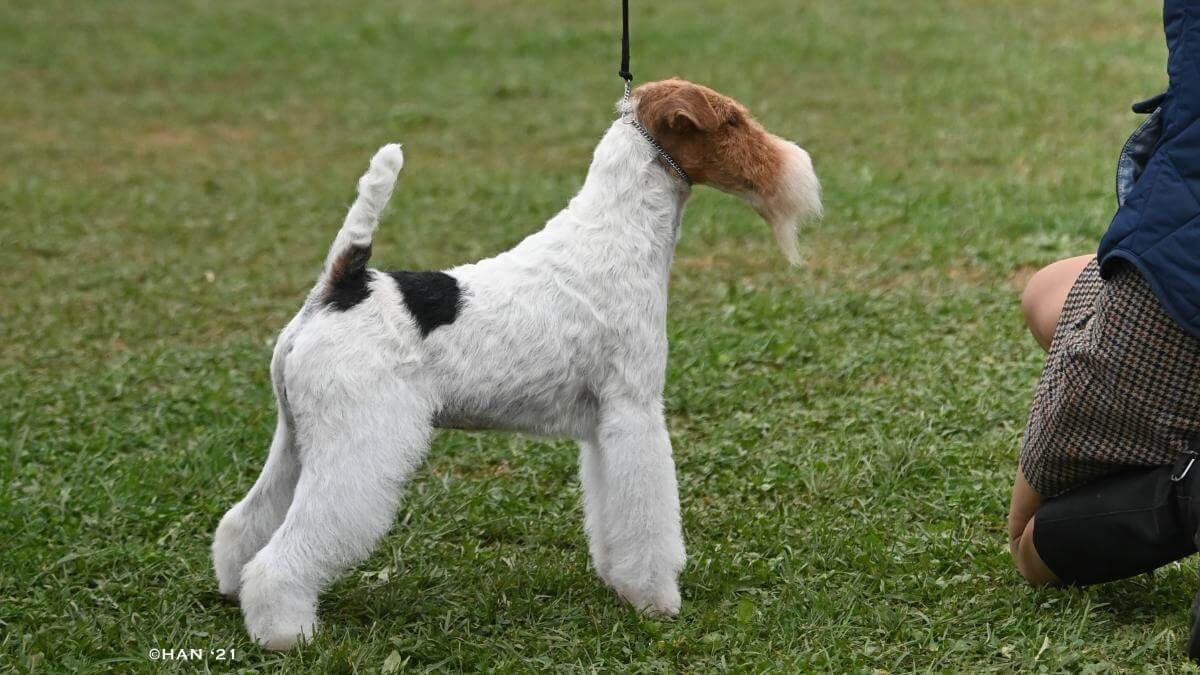


Home » Judging the Wire Fox Terrier

This article was originally published in Showsight Magazine, May 2013 issue.
When judging Wires, exactly what makes a Wire Mr. or Ms. “IT”? First, if the Wire is a dog, does it look like a dog; if it’s a bitch, does it look like a bitch? One should not have to look between its legs to determine its sex. A dog that has proper substance does not look like a bitch because the dog is the correct size (15½”) and is among larger bitches. The Wire’s size does not necessarily correlate with its sex. Second, is the dog balanced? Balance means that the individual parts blend well together, creating a profile of unity, which occurs when no entity dominates the composition.
For example, if your eye is drawn to its shoulders, it’s likely heavy in the shoulders. Ideally, the eye should easily flow over the exhibit. In profile, one can/should check the following: Is the short back level? Are the height at withers and length of body the same? Is the distance from the withers to the elbow the same as from the elbow to the ground? Are its feet cat-like, tight and round? Does it have a fishhook front (i.e., a straight imaginary line can be run uprightly from the toes to the prosternum, neck, and jaw, where the line hooks at the throat that forms a graceful line) with no forechest apparent? Are its hocks relatively short and perpendicular to the ground? Does it have butt behind its tail? A Wire with nothing behind its tail looks more like a figurine in which the artist, only as an afterthought, stuck on a tail. It lacks unity. What about its rear angulation? Moderate angulation is ideal. Are its first and second thighs of the same length, and is the second thigh well muscled? The tail should be highly set, of strong substance, and held at about 10 to 12 o’clock. Ideally, when stacked, its length should reach the height of the top of the head. The tail may have a slight forward curve.
Third, does it project the Wire temperament? It should be “alert, quick of movement, keen of expression, on the tiptoe of expectation at the slightest provocation.” In the ring, the Wire should be looking about, reacting to sounds and sights, perhaps wagging his tail at something of interest. Please never forget that you are in a conformation ring, not an obedience ring, and judge accordingly. Sparring brings out temperament as well as physical components, individually and as a functioning unit. Sparring exposes the soul of the Wire. Unfortunately, sparring, previously an integral highlight of judging Wires, is today too often excluded from the judging process, even at specialties. When a Wire puts his heart into a spar, you know everything about him. It’s his defining moment. During the spar, the exhibitor should not be allowed to stack his dog, “bait” his dog, attract the attention of his dog, etc.
Dogs should be allowed to show themselves via their posturing during confrontation. If a Wire cowers during the spar, he most definitely should not receive awards. Spar for WD, WB and Breed awards. Fourth, examine the head and check its expression. Some say the Wire is “a head breed.” Is the head really the bottom line for rating a Wire a “10”? The comeback, of course, is, “They don’t walk on their heads.” The size of the head should be in proportion to the rest of the dog, not exceeding 3½” inches in width. The head length should measure slightly more than 7″ with its foreface and relatively flat skull being about the same length. The black, round, moderate-sized eyes should be deeply set, full of life, and not too far apart. The V-shaped ears should be set at the corners of the head and break (fold) well above the head, dropping forward, not carried to the side like an Airedale’s. The tip of the ear should fall near the outer corner of the eye. It should be closed but not necessarily touching the skull.
Correct ear carriage is absolutely essential for correct expression. There should be fill under the eyes, and the nose should be black. Bony, muscled cheeks are not desirable. Neither is a prominent brow or prominent occiput. The teeth should be relatively large and meet in a scissors bite. Fifth, does the Wire move properly? Movement and conformation interplay. Are the front legs parallel and the rear legs parallel to each other when stationary and during movement? When viewed from the side, do its front and rear legs nearly meet at the ground during movement? Short, pitter-patter steps can simply ruin the overall impression that the dog projects. Also, temperament can influence movement, although this is often forgotten. A shy or ill-at-ease dog is not likely to move correctly even if it is correctly built. Sixth, Coat and Grooming: The Wire’s Coat should be of prime consideration. The Wire is double coated, with a hard, intensely colored Wire outer coat and a soft, muted gray undercoat.
The only color that the coat MUST be is white. An all-white Wire is perfectly correct. The Wire coat should be (NOT “must be”) at least 50% white. Although there is no disqualification for color, slatey blue, red, and liver are very objectionable, as is a brindle (i.e., striped) pattern. Brown, black, and ginger are not mentioned in the Wire Standard! Two color types are possible: a tri-colored Wire (i.e., white, black and brown) and a ginger Wire (i.e., ginger and white). The ginger color is more tannish than the brown on the tri-Wire. Neither color type is preferred. Significant brown dispersed within the black markings is not desirable. Please do not allow markings to deceive your honest evaluation of a dog. Forget about markings, but note how markings can “color” your vision. Disqualifications Know (and enforce) the WFT Disqualifications: 1. Ears prick, tulip or rose 2. Nose white, cherry or spotted to a considerable extent with either of these colors 3. Mouth much undershot, or much overshot Additional Thoughts Don’t be afraid to “mess up” hair to examine the Wires. If the exhibitor grimaces, that’s too bad. That’s why he/she takes a comb into the ring.
Please remember that you are judging conformation, not a grooming competition or obedience. The Wire has ample coat to accommodate the talented groomer. As one handler remarked to me, “It’s amazing what you can do with a quarter inch of hair!” Think of yourself as a Wire breeder, and imagine that you are selecting dogs that will be incorporated into your breeding program. In that case, which would you choose? Do that! Finally, considering all the above, what is a “10”? Is it a typey, sound, well-marked, alert, nicely balanced, good moving, well-put-down Wire with a super head? Maybe. Suppose the head is good but not great, but its movement is superb? Suppose… suppose… suppose… Some say a “10” is a one-piece dog that is a complete package. Some say… Hey, wait a minute! What would The US Supreme Court say? Perhaps the most often quoted sentence ever to emerge from the Court, used (1964) by Justice Potter Stewart in an obscenity case to define pornography, can also be used as the absolute bottom line for rating a Wire a “10”: I KNOW IT WHEN I SEE IT. Good luck!